Investigation of Targeted Process Control for Adjusting the Macrostructure of Freeze Foams Using In Situ Computed Tomography
Abstract
:1. Introduction
2. Materials and Methods
2.1. Material—Model Suspension
2.2. Methods—DoE with Radiographical and Computed-Tomography (CT) Evaluation
3. Results
3.1. Foaming
- Beginning of the foaming process
- End of the foaming process
- Foam growth
3.2. Porosity
3.3. Pore Size Distribution
3.4. Strut Thickness
4. Discussion
5. Conclusions
Author Contributions
Funding
Institutional Review Board Statement
Informed Consent Statement
Data Availability Statement
Acknowledgments
Conflicts of Interest
References
- Palma, V.; Ruocco, C.; Castaldo, F.; Ricca, A.; Boettge, D. Ethanol steam reforming over bimetallic coated ceramic foams: Effect of reactor configuration and catalytic support. Int. J. Hydrogen Energy 2015, 40, 12650–12662. [Google Scholar] [CrossRef]
- Luo, H.; Li, Y.; Xiang, R.; Li, S.; Luo, J.; Wang, H.; Li, X. Novel aluminum borate foams with controllable structures as exquisite high-temperature thermal insulators. J. Eur. Ceram. Soc. 2020, 40, 173–180. [Google Scholar] [CrossRef]
- Ahmad, S.; Latif, M.A.; Taib, H.; Ismail, A.F. Short Review: Ceramic Foam Fabrication Techniques for Wastewater Treatment Application. In Proceedings of the 2nd International Conference on Sustainable Materials (ICoSM 2013), Penang, Malaysia, 26–27 March 2013; Volume 795, pp. 5–8. [Google Scholar]
- Olson, R.A., III; Martins, L.C.B. Cellular Ceramics in Metal Filtration. Adv. Eng. Mater. 2005, 7, 187–192. [Google Scholar] [CrossRef]
- Juhasz, J.A.; Best, S.M. Bioactive ceramics: Processing, structures and properties. J. Mater. Sci. 2012, 47, 610–624. [Google Scholar] [CrossRef]
- Albulescu, R.; Popa, A.C.; Enciu, A.M.; Albulescu, L.; Dudau, M.; Popescu, I.D.; Mihai, S.; Codrici, E.; Pop, S.; Lupu, A.-R.; et al. Comprehensive in vitro testing of calcium phosphate-based bioceramics with orthopedic and dentistry applications. Materials 2019, 12, 3704. [Google Scholar] [CrossRef] [PubMed] [Green Version]
- Takemoto, M.; Fujibayashi, S.; Neo, M.; Suzuki, J.; Kokubo, T.; Nakamura, T. Mechanical properties and osteoconductivity of porous bioactive titanium. Biomaterials 2005, 26, 6014–6023. [Google Scholar] [CrossRef] [PubMed]
- Zwingenberger, S.; Nich, C.; Valladares, R.D.; Yao, Z.; Stiehler, M.; Goodman, S.B. Recommendations and considerations for the use of biologics in orthopedic surgery. BioDrugs 2012, 26, 245–256. [Google Scholar] [CrossRef] [PubMed]
- Beig, B.; Liaqat, U.; Niazi MF, K.; Douna, I.; Zahoor, M.; Niazi, M.B.K. Current challenges and innovative developments in hydroxyapatite-based coatings on metallic materials for bone implantation: A review. Coatings 2020, 10, 1249. [Google Scholar] [CrossRef]
- Rastogi, V.K.; Jiang, B.; Sturzenegger, P.N.; Gonzenbach, U.T.; Vetterli, M.; Blugan, G.; Kuebler, J. A processing route for dip-coating and characterization of multi-structured ceramic foam. Ceram. Int. 2019, 45, 21887–21893. [Google Scholar] [CrossRef]
- Karl, S.; Somers, A.V. Method of Making Porous Ceramic Articles. Google Patent US3090094A, 21 May 1963. [Google Scholar]
- Colonetti, V.; Sanches, M.; de Souza, V.; Fernandes, C.; Hotza, D.; Quadri, M. Cellular ceramics obtained by a combination of direct foaming of soybean oil emulsified alumina suspensions with gel consolidation using gelatin. Ceram. Int. 2018, 44, 2436–2445. [Google Scholar] [CrossRef]
- Ahlhelm, M.; Werner, D.; Maier, J.; Abel, J.; Behnisch, T.; Moritz, T.; Michaelis, A.; Gude, M. Evaluation of the pore morphology formation of the Freeze Foaming process by in situ computed tomography. J. Eur. Ceram. Soc. 2018, 38, 3369–3378. [Google Scholar] [CrossRef]
- Ahlhelm, M.; Latorre, S.H.; Mayr, H.O.; Storch, C.; Freytag, C.; Werner, D.; Schwarzer-Fischer, E.; Seidenstücker, M. Mechanically Stable β-TCP Structural Hybrid Scaffolds for Potential Bone Replacement. J. Compos. Sci. 2021, 5, 281. [Google Scholar] [CrossRef]
- Werner, D.; Maier, J.; Kaube, N.; Geske, V.; Behnisch, T.; Ahlhelm, M.; Moritz, T.; Michaelis, A.; Gude, M. Tailoring of hierarchical porous freeze foam structures. Materials 2022, 15, 836. [Google Scholar] [CrossRef] [PubMed]
- Ni, Y.; Liao, H.; Zhao, Q.; Wu, W.; Shi, Y.; Wu, S. Investigations of the failure behaviors of open-cell copper foam based on in-situ X-ray tomography compression experiments and image reconstructed finite element modeling. Eng. Fract. Mech. 2022, 263, 108323. [Google Scholar] [CrossRef]
- Luksic, S.A.; Pokorny, R.; George, J.; Hrma, P.; Varga, T.; Reno, L.R.; Buchko, A.C.; Kruger, A.A. In situ characterization of foam morphology during melting of simulated waste glass using x-ray computed tomography. Ceram. Int. 2020, 46, 17176–17185. [Google Scholar] [CrossRef]
- Kamm, P.H.; García-Moreno, F.; Neu, T.R.; Heim, K.; Mokso, R.; Banhart, J. Fast Synchrotron X-ray Tomography of Dynamic Processes in Liquid Aluminium Alloy Foam. Adv. Eng. Mater. 2017, 19, 1600550. [Google Scholar] [CrossRef]
- Maier, J.; Behnisch, T.; Geske, V.; Ahlhelm, M.; Werner, D.; Moritz, T.; Michaelis, A.; Gude, M. Investigation of the Foam Development Stages by Non-Destructive Testing Technology Using the Freeze Foaming Process. Materials 2018, 11, 2478. [Google Scholar] [CrossRef] [PubMed] [Green Version]
- Eriksson, L.; Johansson, E.; Kettaneh-Wold, N.; Wikström, C.; Wold, S. Design of Experiments: Principles and Applications; Umetrics AB, Umeå Learnways AB: Stockholm, Sweden, 2000. [Google Scholar]
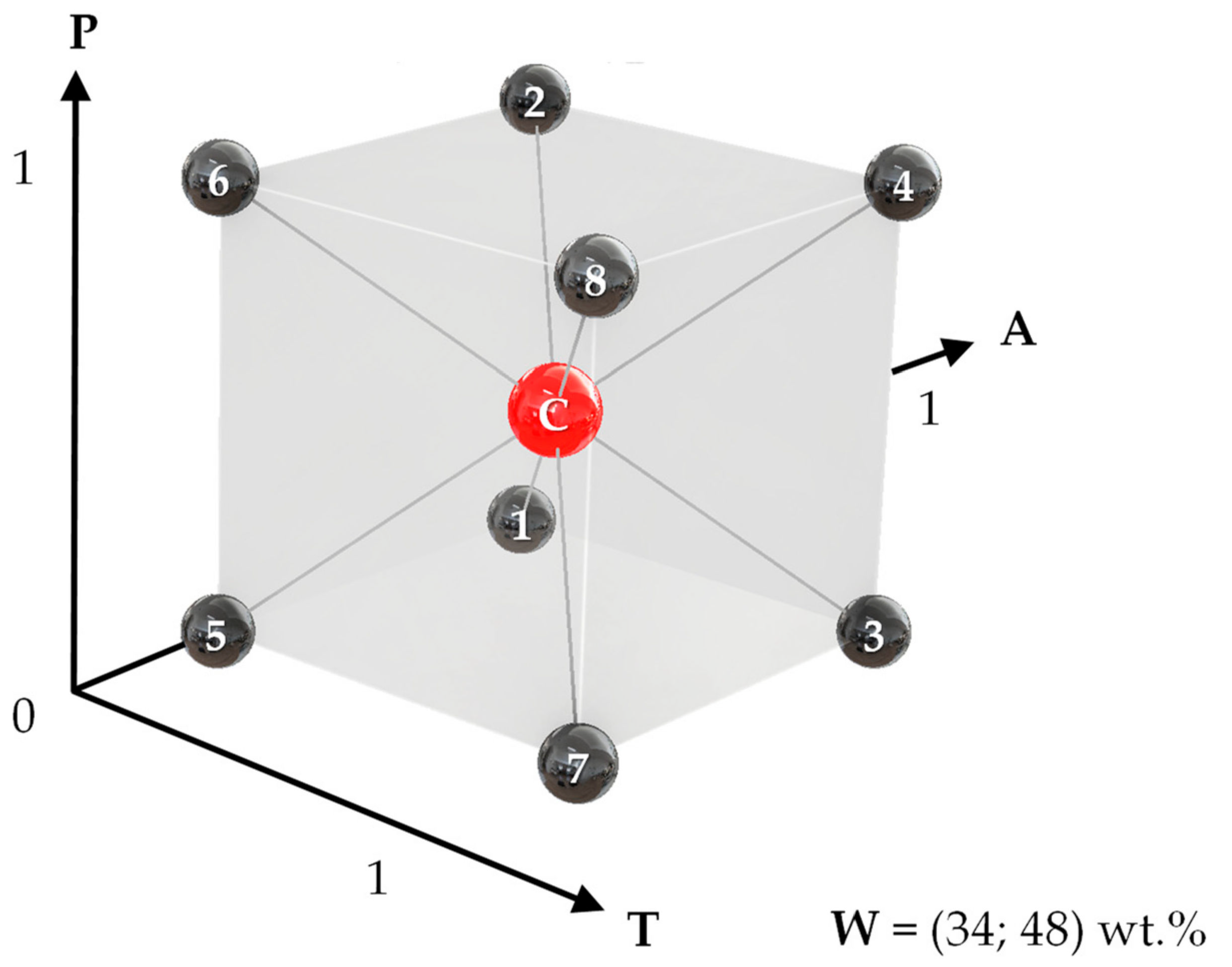
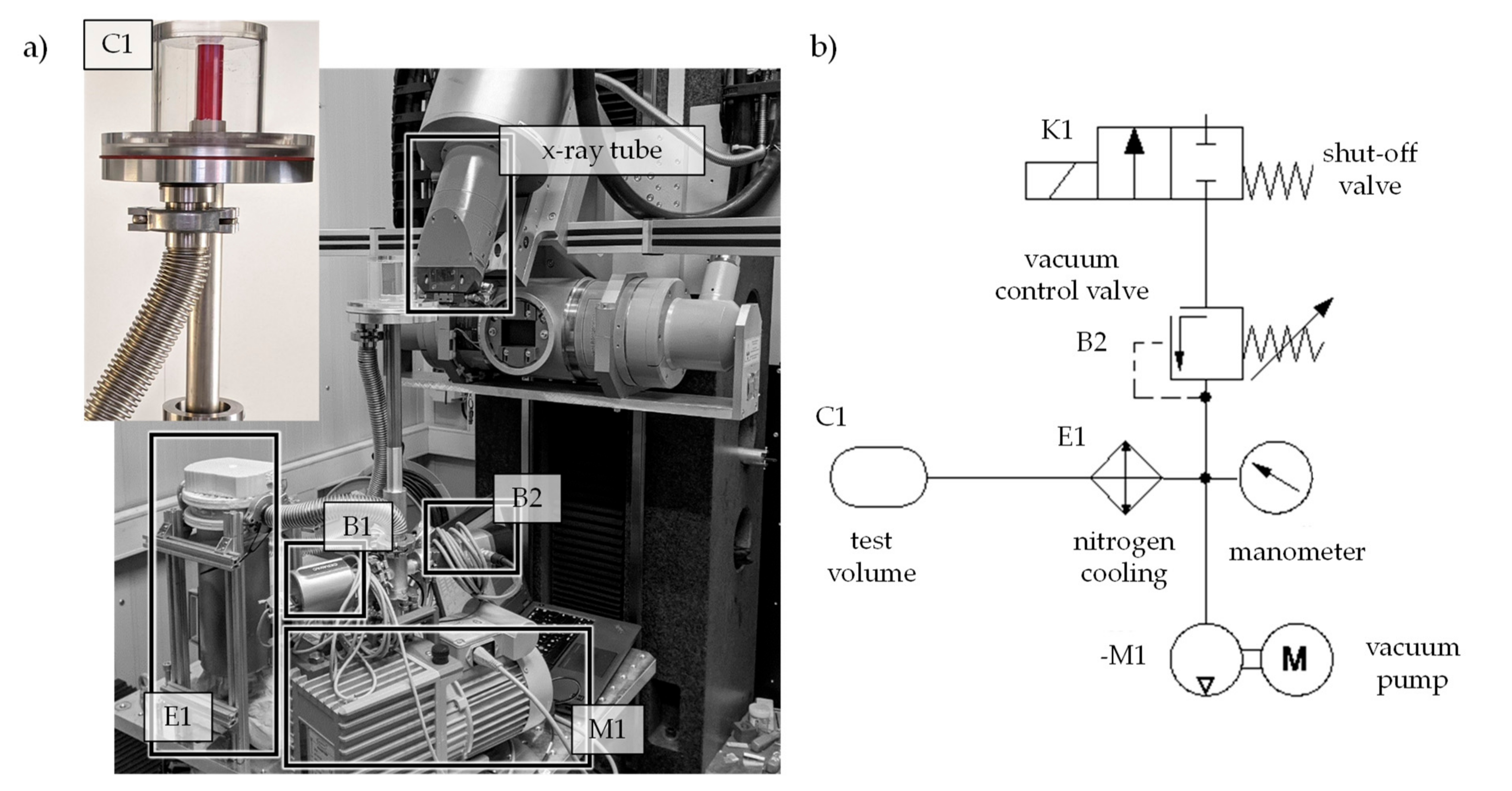

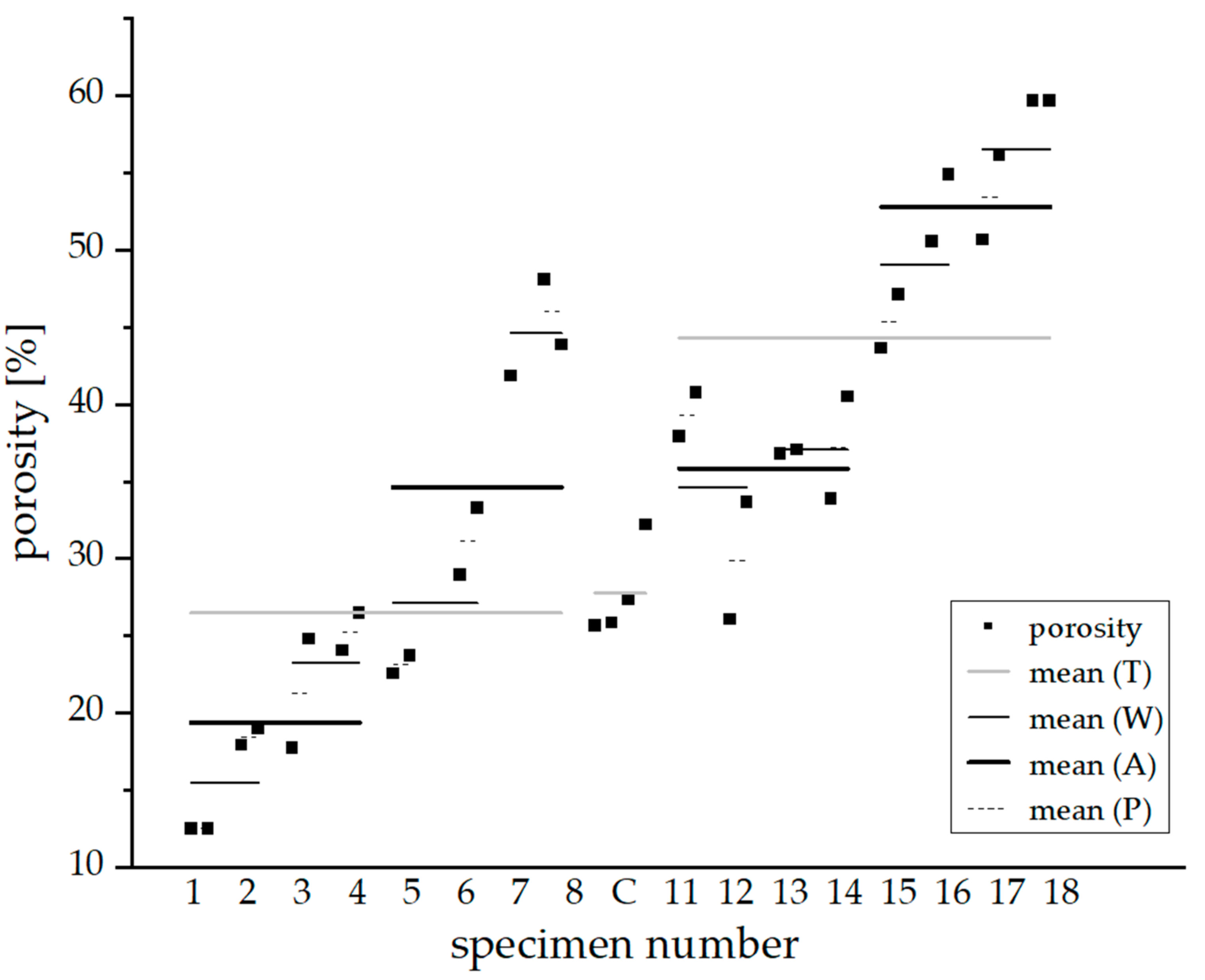

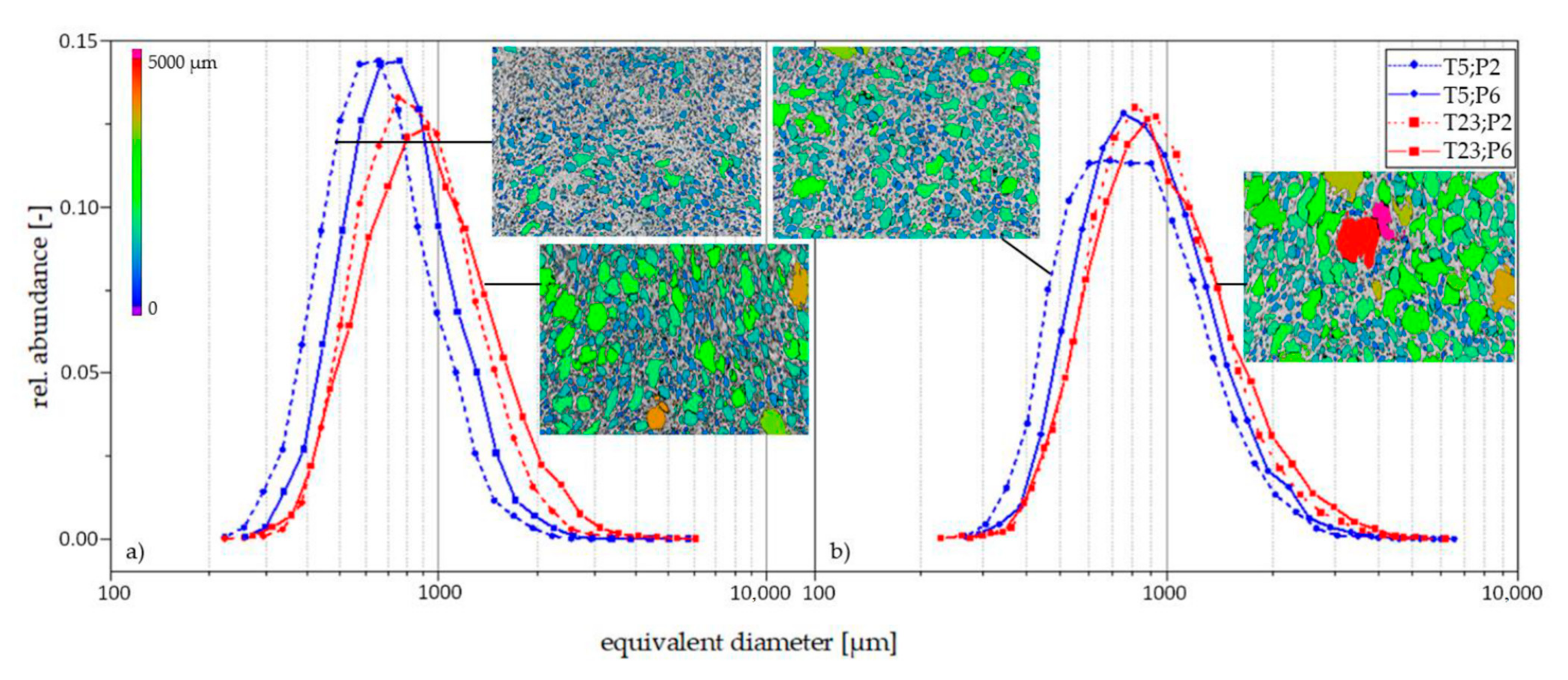
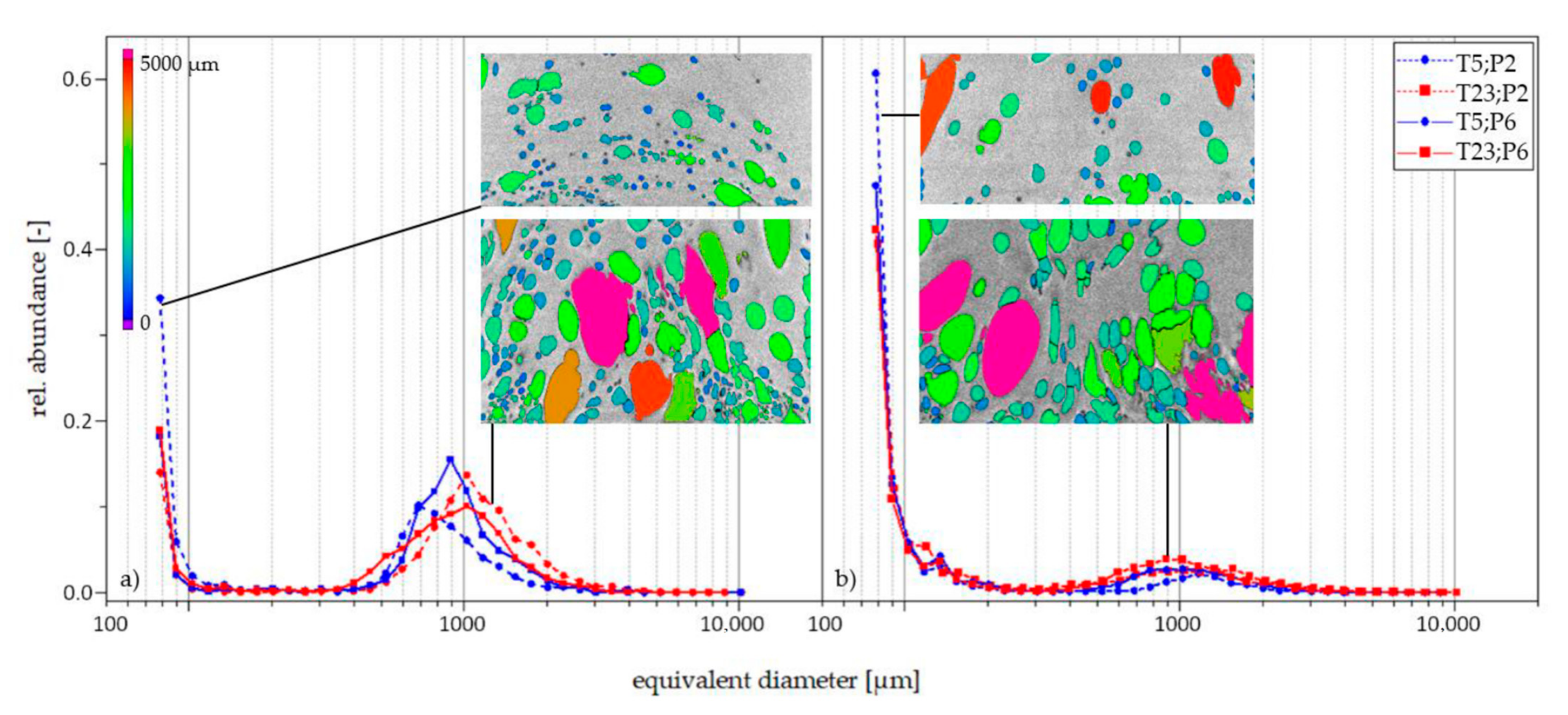
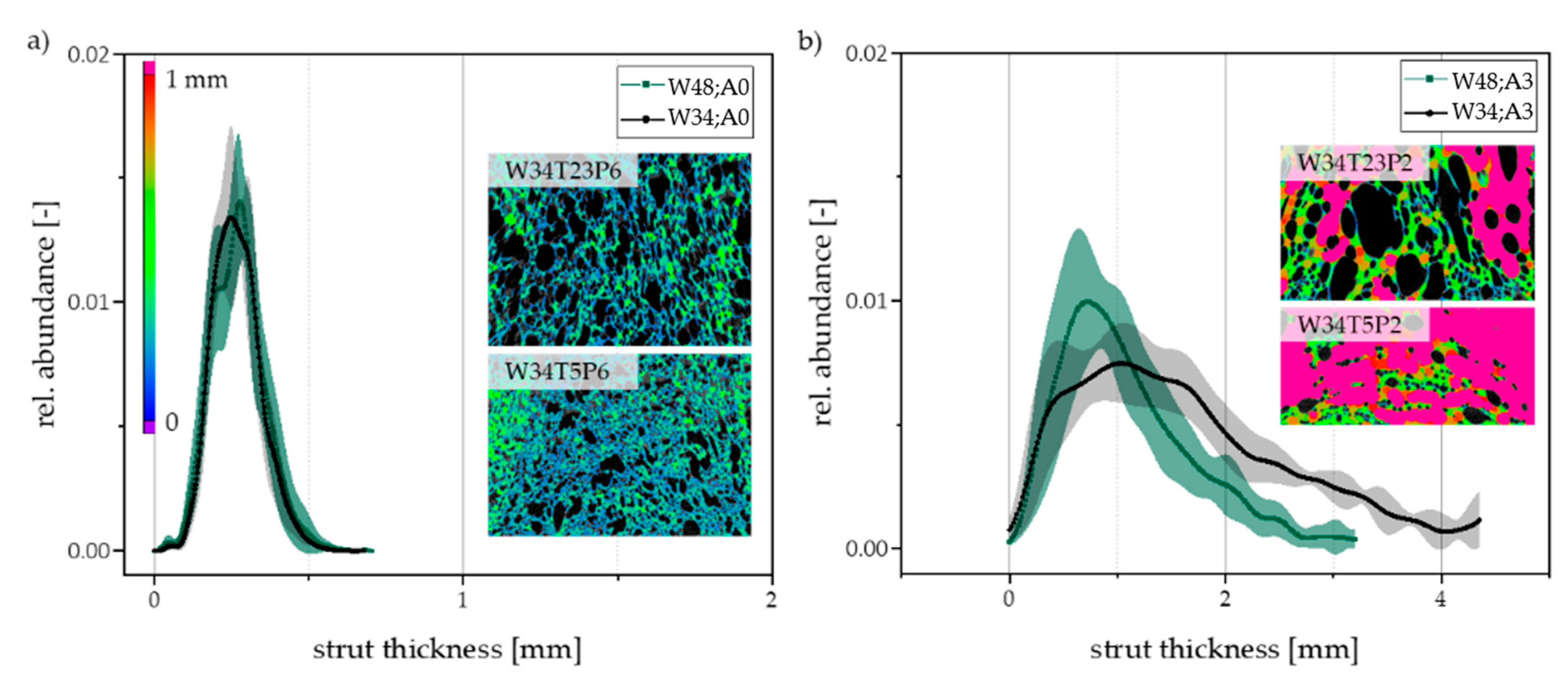
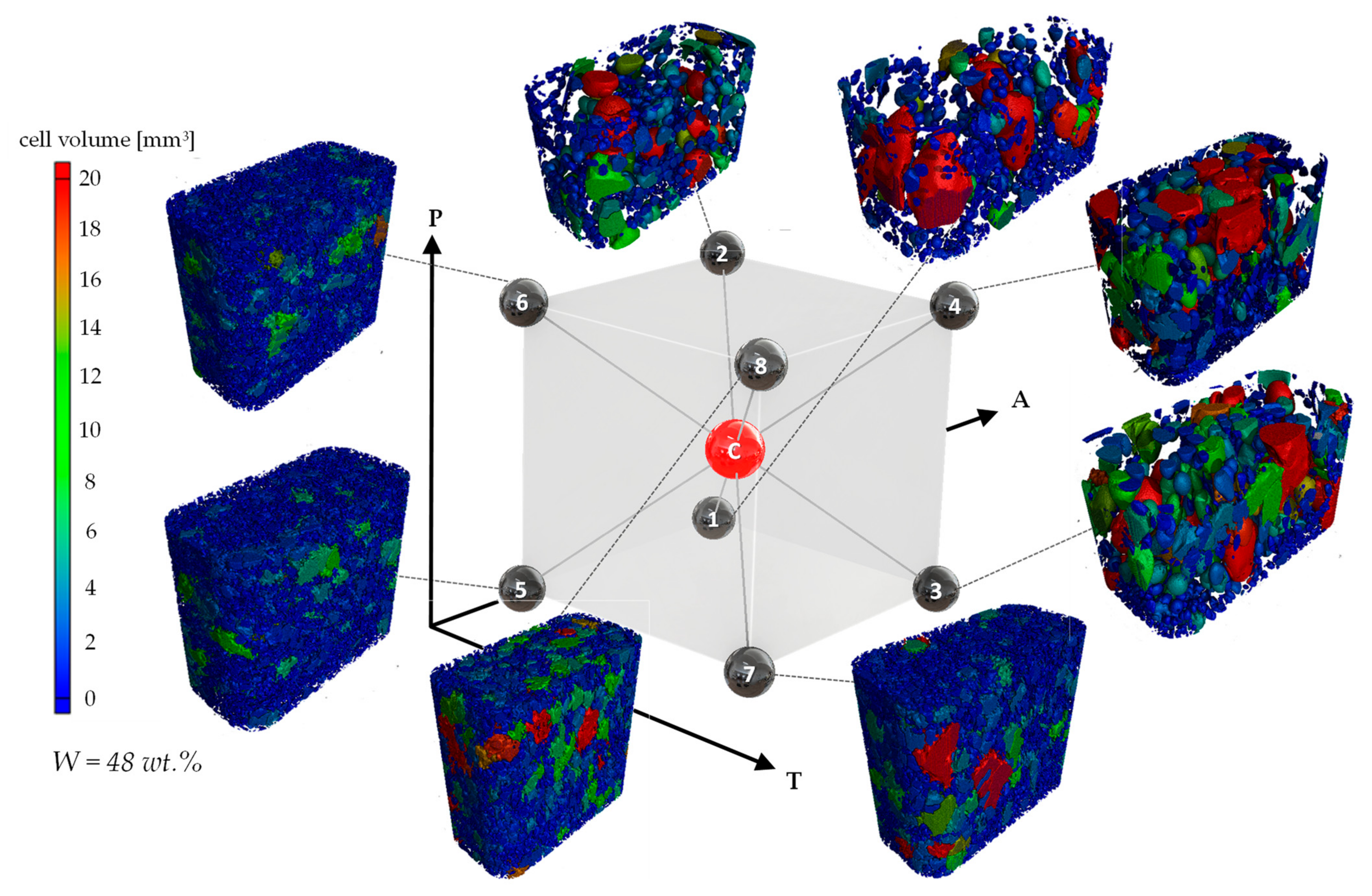
| Number | 1 | 2 | 3 | 4 | 5 | 6 | 7 | 8 | C | 11 | 12 | 13 | 14 | 15 | 16 | 17 | 18 |
|---|---|---|---|---|---|---|---|---|---|---|---|---|---|---|---|---|---|
| T [°C] | 5 | 5 | 5 | 5 | 5 | 5 | 5 | 5 | 14 | 23 | 23 | 23 | 23 | 23 | 23 | 23 | 23 |
| A [min] | 3 | 3 | 3 | 3 | 0 | 0 | 0 | 0 | 1.5 | 3 | 3 | 3 | 3 | 0 | 0 | 0 | 0 |
| W [wt.%] | 34 | 34 | 48 | 48 | 34 | 34 | 48 | 48 | 41 | 34 | 34 | 48 | 48 | 34 | 34 | 48 | 48 |
| P [min] | 2 | 6 | 2 | 6 | 2 | 6 | 2 | 6 | 4 | 2 | 6 | 2 | 6 | 2 | 6 | 2 | 6 |
Publisher’s Note: MDPI stays neutral with regard to jurisdictional claims in published maps and institutional affiliations. |
© 2022 by the authors. Licensee MDPI, Basel, Switzerland. This article is an open access article distributed under the terms and conditions of the Creative Commons Attribution (CC BY) license (https://creativecommons.org/licenses/by/4.0/).
Share and Cite
Maier, J.; Geske, V.; Werner, D.; Behnisch, T.; Ahlhelm, M.; Moritz, T.; Michaelis, A.; Gude, M. Investigation of Targeted Process Control for Adjusting the Macrostructure of Freeze Foams Using In Situ Computed Tomography. Ceramics 2022, 5, 269-280. https://doi.org/10.3390/ceramics5030021
Maier J, Geske V, Werner D, Behnisch T, Ahlhelm M, Moritz T, Michaelis A, Gude M. Investigation of Targeted Process Control for Adjusting the Macrostructure of Freeze Foams Using In Situ Computed Tomography. Ceramics. 2022; 5(3):269-280. https://doi.org/10.3390/ceramics5030021
Chicago/Turabian StyleMaier, Johanna, Vinzenz Geske, David Werner, Thomas Behnisch, Matthias Ahlhelm, Tassilo Moritz, Alexander Michaelis, and Maik Gude. 2022. "Investigation of Targeted Process Control for Adjusting the Macrostructure of Freeze Foams Using In Situ Computed Tomography" Ceramics 5, no. 3: 269-280. https://doi.org/10.3390/ceramics5030021
APA StyleMaier, J., Geske, V., Werner, D., Behnisch, T., Ahlhelm, M., Moritz, T., Michaelis, A., & Gude, M. (2022). Investigation of Targeted Process Control for Adjusting the Macrostructure of Freeze Foams Using In Situ Computed Tomography. Ceramics, 5(3), 269-280. https://doi.org/10.3390/ceramics5030021









